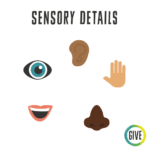감각적 디테일
제공자 메리 키니
![]()
설명
In this language-building activity, students will learn and practice using sensory descriptors in their writing.
지도
- Present a lemon to the class. Going around the room, student volunteers share descriptors for the lemon. Ask, “What does a lemon smell like (without using the word lemon!)?” When asking what it sounds like, you can toss and catch the lemon or softly tap the lemon. Students can also mention dishes with lemon that they have had at home. Encourage students to be creative and specific with their descriptors, inviting similes and personification (if discussing this in class).
- Present each table with a “mystery bag.” One of the five senses is listed on the outside, and a mystery item is on the inside. On “Go,” students will have four minutes to list as many descriptors of their mystery item using only the sense written on the outside.
- When time is up, each table group counts its total. Each table shares their item and their list with the class
- Sample mystery items: cinnamon stick, coffee bean, leaf, shoelace, penny, foil. For taste, use something most people have probably tasted before (lemon, cinnamon, etc.).
- 반사
- Students reflect on how challenging/easy it was to focus on one sense, and share different strategies they used to get as many descriptors as possible.
- Possible adjustments depending on the group of students
- Whichever group gets the most descriptors about their item wins.
- Have the rest of the class guess what each item was, based on each group’s descriptions.
활동으로의 전환
Have a lemon in a brown paper bag. Ask students to guess what is in the bag. Use a few descriptors before revealing the lemon.
활동에서 전환
Collect sensory materials while the class gives snaps to the groups that came up with delicious details. Take a deep breath in and out collectively before moving on to the next activity.
교실 배치
Table groups.
지지대/적응 재료/도구
- Students who are less verbal may be invited to draw some examples.
- Dim lights to support sensory focusing.
- Group brainstorming, working with lemon example.
- Have a sensory word bank that students can pull from, to relieve the pressure of generating their own.
- Use 시각적 어휘 such as the sensory details image to remind students of the senses.

수업 전문가를 위한 가능한 역할
- Join table groups of students who may find this more challenging.
- Support by adding descriptors to the class list.
원격 교육을 위한 조정
Students can work in breakout rooms
on additional items after being given clear instructions on what sense to use for their descriptors.

